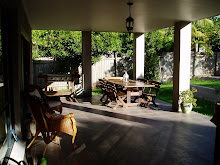Getting people together to consult is great - enables us to explain verbally and in writing (before the meeting) why we need an accessible house and also why the world needs universal design. And we learn from the rest of the team the issues they need to address and why.
We identified some key challenges and worked out an action plan along with a contingency plan, which I suspect will become the action plan.
But I felt depressed. Depressed that we spent considerable time and incurred costs to discuss the minutae of shifting the property maybe 20cm to comply with building codes.
Do the building codes address how important it is now and in the immediate future to modify and create houses that meet changing demographic needs?
Nah, what our team needs to know is how to manage house location within 20% of average surrounding setback ... or something like that. Because that's what the local building code specifies, so that's what's important. If our team can do that they can help us get into our house faster. For which we are grateful.
But I wish I when I contacted the planning authority initially to discuss all this, someone could have said:
"You're modifying a family home in a growing city using universal design principles? What foresight you show! How can we help you achieve your goal and create a house that anyone of any ability can live in?"
Why do we need houses that anyone can live in? I'll leave it to Queensland Action for Universal Housing Design to answer that:
- Queensland has a growth rate, currently at 4.25 per cent, consistently higher than the national average for more than 13 years.
- Queensland experienced the highest positive net interstate migration with a gain of 20,000 persons in the last year.
- Queensland is projected to experience the largest percentage increase in population (in Australia) between 30 June 2007 and 2056, more than doubling the 2007 population of 4.2 million to 8.7 million people by 2056. It is projected to replace Victoria as Australia's second most populous state in 2050.
- With South Australia and Tasmania, Queensland has the highest percentage per capita of people who are ageing or who have a disability and this percentage is expected to rise.
- Queensland will face the greatest challenge if we don’t get it right.
The time to act is now. If included from the start, universal housing design will cost no more.


No comments:
Post a Comment